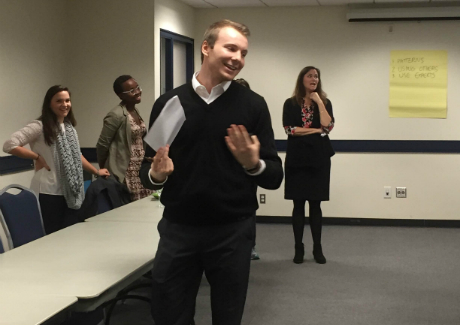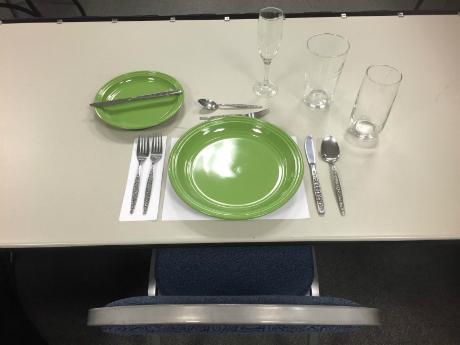During the weekly meeting on Tuesday, October 11th, I led the PAFs and PAF Advising Team (PAT) in an experiential learning exercise to improve our Learning Agility skills. The PAFs & PAT were challenged to “set the table” using provided plateware and silverware as if they were a server and it was their first day at a five-star restaurant. The groups had three-minutes to “learn on the fly” how to set the table with very little assistance.
After an intense three minutes, we debriefed to discover how the groups went about “setting the table.” Some deferred to PAT present in their group who had more fine-dining experience, some looked-up the answer on their phone, and some went with their gut. None of the groups, however, looked at what the other groups were doing, and every group immediately started “setting the table” once time began. At the end of the debrief, I judged each group’s set-up, and no group had “set the table” exactly correct.
From these observations, we identified four strategies for how one can improve his or her Learning Agility when performing a new task or when given a new project.
1. Looking for patterns – One thing that the groups did not do, was look at what the other teams were doing in effort to identify any commonalities in how each team was “setting the table.” One effective Learning Agility strategy we identified is to look for what is common to each success, or look for the patterns. Identifying patterns allows one to analyze successes and what worked.
2. Use others/experts – Some of the groups thought to look-up the answer on their phone or ask for help from PAT members in their group who had fine-dining experience. The second Learning Agility strategy we identified is to ask others or seek out experts who understand how to think about the problem at hand. However, seeing as no group was completely correct in “setting the table,” we noted that a quick Google search and relying on others’ perspective does not always give you to the correct answer. Yet, others and experts can help frame how to solve the problem and suggest potential solutions.
3. Don’t jump to solutions – I mentioned that each group immediately started “setting the table.” Too often we jump to thinking about solutions. The third Learning Agility strategy we identified is that 50% of time available should be spent defining the problem and asking questions, while the other 50% of the time should be spent formulating solutions. Perhaps, had the groups taken more time to define the problem and allow for questions, they might have arrived at a more successful solution.
4. Embrace failure – The realization that no one “set the table” correctly allowed us to explore the idea that failure is often inevitable when exercising Learning Agility. The fourth Learning Agility strategy we identified is that one should not expect to “get it right the first time.” By embracing the likelihood of failure, one can also make an effort to actively seek more immediate feedback loops from peers or management in order to learn from mistakes and arrive at a solution that weathered failure and subsequently has a higher likelihood of being a better solution.



